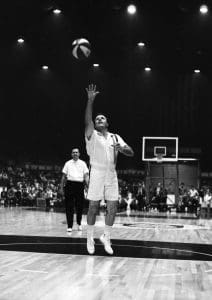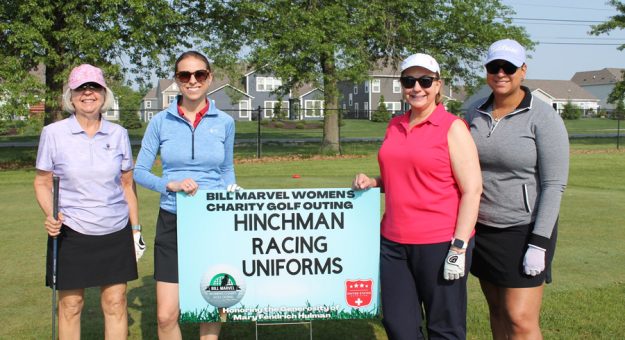The divisiveness that seems to mar daily life at every turn is certainly wearisome for most of us. On a much smaller scale, given the raw emotion and intensity that undergirds auto racing differences and squabbles are predictable.
Yet, there are moments when the racing community collectively closes rank and draws support from one another. Strong bonds develop between all participants and in short-track racing the ability for fans to genuinely interact with many of the top stars is a rarity in professional sports.
It is obvious that racing is a dangerous enterprise that puts many people in harm’s way on a regular basis. Tragedy can occur, and even relatively minor incidents can have serious fiscal consequences for those who earn a paycheck from racing.
Certainly, many sanctioning bodies provide insurance coverage for members, and other supplementary insurance programs exist. Nonetheless, leaders in the American Automobile Ass’n, the premier sanctioning body for the bulk of the 20th century knew an additional safety net was needed.
RACEAID, under the United States Auto Club banner, is a direct descendant of the original efforts extended by the AAA decades ago. The history of RACEAID dates back to 1934 when the AAA Contest Board began a “Benevolent Fund” to serve as an insurance program for racing participants.
At first the maximum benefit was $1,200 per accident, although it would expand over time.
This effort was funded through a “benevolent fee” appended to the cost of a pit pass. This continued until 1937 when coverage for participants was arranged via the Continental Casualty Insurance Company.
We have all experienced a range of ad hoc efforts to support a driver in need. Whether it is passing through the stands with helmets, raffles, or online solicitation for support, these initiatives continue apace. This method of mutual aid also has a long history,
For example, in 1956 efforts to help Andy Linden (he would need much greater assistance at the end of 1957) included collections at the famed Mates White Front tavern and Petrovich’s Mobile service station in Speedway. The efforts have always been appreciated but shortly after the formation of USAC leading officials had a desire to do more.
Thus, during the 1958 annual meeting the board established the Benevolent Fund Committee with a charge to “administer those funds accumulated.” Where were such funds accumulated? It turns out they were under the lock and key of the American Automobile Ass’n.
To that end USAC President Tom Binford and Indianapolis attorney John Kitchen, who donated his services, ventured to Washington, D.C., to seek the available funds from the AAA brass. Basic persuasion proved to be inadequate, and the matter ended up in court.
The October 29, 1959, edition of USAC News shared the good news.
“A United States District court in Washington, D.C., awarded the funds of the now defunct AAA Contest Board Benevolent Association to the United States Auto Club Benevolent Association on Monday, October 26. The United States Auto Club Benevolent Association was formed under the Corporation Laws of the District of Columbia on April 8, 1959.

“It was organized at the request of the officers and directors of USAC, Inc. for the purpose of having a separate corporation to deal with Benevolent Fund expenditures for injured drivers and race crews, in addition to any insurance coverage which such drivers and officials might carry.”
Officers and directors of the Benevolent Association were established with Tom Binford serving as president, Tony Hulman was named vice president along with car owner Lindsey Hopkins.
Former National Champion (and soon to be the USAC Director of Competition) Henry Banks would serve as executive secretary, Howard Wilcox was named treasurer, while John Kitchen filled the role of general counsel. Two former directors of the fund for the AAA, Art Pilsbury and Tom Frost would remain in that capacity.
The ability to grow available funds was abetted in 1962 when the Internal Revenue Service deemed that the USAC Benevolent Association, Inc. qualified as a tax-exempt organization. This opened the door for charitable contributions from individuals and via fundraising activities.
Vital then and now is the existence of an independent board to oversee operations.
Fundraisers from that point came in all shapes and sizes.
For example, in 1962 for a one dollar contribution fans could head to the Tower Terrace at IMS and get their picture taken with drivers such as Parnelli Jones, Jim McElreath, Bobby Marshman, Don Branson, A.J. Foyt, Dan Gurney, Bobby Grim, Rodger Ward, Troy Ruttman, Cliff Griffith, Eddie Sachs, Dempsey Wilson, Len Sutton, Duane Carter, Jim Hurtubise, Ralph Liguori, Don Davis and 1927 winner, George Souders. It was promised that the mounted photos would be mailed within four days.
A more utilitarian fundraiser involved the introduction of seat belt laws. Thus, in 1963 you could purchase a seat belt at the USAC office and $2 would be donated to the Benevolent Foundation. By now word had spread about the fund, and with some regularity families from within racing circles would suggest a donation in honor of a loved one.
Then there were simple touches of kindness as represented by the efforts of four sixth grade students at Fisher School in Speedway. Kevin Conolty, Dusty Wood, Allen Workman, and Chuck Hoffman placed six handmade boxes in Speedway stores to collect money in the memory of Jim Malloy who lost his life in a 1972 practice crash at the speedway.
The boys raised a total of $67.96 but used 10 dollars to purchase flowers for the memorial service.
By the mid-1960s Judge George Ober, one of the founders of the United States Auto Club had moved into the top leadership spot with the Benevolent Foundation and within a few short years the indefatigable Bill Marvel was lending his support to high profile events to advance this important work.
Prominent among these efforts were the famed basketball tilts between USAC stars and media members in conjunction with Indiana Pacers games. All the household names were on hand. Sid Collins would manage public address duties while Pat Vidan and Indianapolis Star motorsports writer Dave Overpeck served as officials for these unconventional contests.
Consistent with the intent of the function the 1968 game was staged to aid injured driver Bob Hurt, and by 1970 interest was piqued in some corners when Miss Hurst Golden Shifter, Linda Vaughn and Miss Hurst Mini-Shifter, June Cochran served on the bench for the USAC team while Union “76” Racestoppers, Bonnie Leigh and Ann Romeo filled that role for the opposition.
Heavy hitters continued to jump in as evidenced by the 1973 contest where Tony Hulman served as the coach for the Dynamic Drivers, while Butler University legend Tony Hinkle directed the action for the Mighty Media.
From there any number of fundraising activities have been used as vehicles to raise funds to disperse to members of the USAC community in need.
Today many current and former USAC participants, family members, media representatives and more have benefitted from these efforts. The fund was rebranded as RACEAID one year ago.
George Ober would lead the organization until shortly before he passed in 1989. Howard Wilcox would fill Ober’s slot in the Presidents role with Bill Marvel carrying the torch for many years. Josh Laycock, a member of one of the most celebrated families at the Brickyard, followed Marvel and capably led the organization for over a decade.
Today Nikki Wilke Klepper serves as the Program Director. Because Klepper grew up in a racing family with deep roots in the sport, it was only natural for her to step into this role.
“Because of my family heritage I have grown up in the sport,” she says, “I know how strong and loyal the racing community is. For me this was a chance to give back. We wish we never had to make grants to people that have suffered accidents or misfortune, but it is a reality. All of us on the board feel a responsibility to help when we can.”
Several events have been held at USAC this year as RACEAID fundraisers, but one function has a long history. In 1996 a women’s tournament was held at Eagle Creek Golf Course in Indianapolis.
Today the function, in honor of a guiding light, is known as the Bill Marvel Women’s Charity Golf Outing. This year’s event will be held on May 22 at Eagle Creek. Registration begins at 7:30 a.m. with an 8:30 shotgun start. Interested parties can register or donate online at RaceAid.fund.
